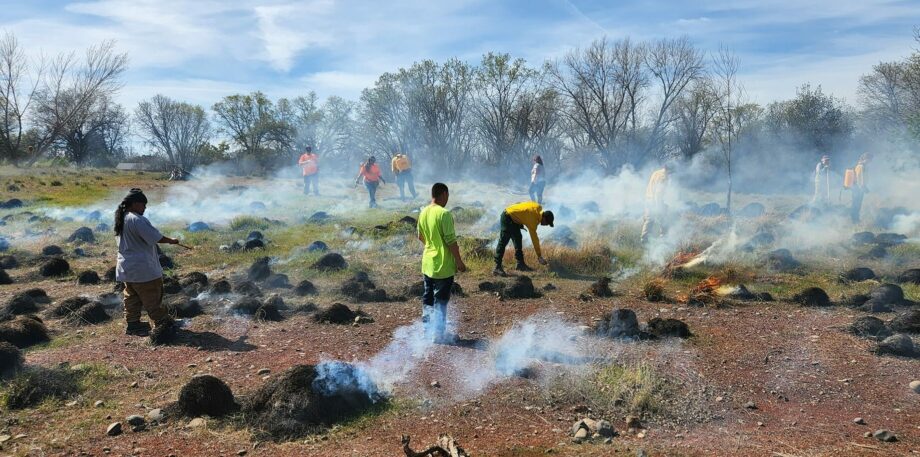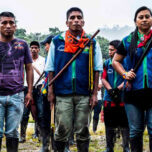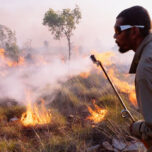August 17, 2022 — 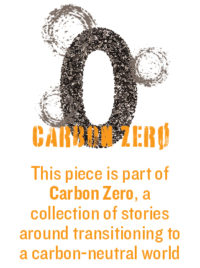 On a cool March day with low humidity and very little wind, Ali Meders-Knight did something that hadn’t been done in her city in over a century when she lit fire to deergrass for a cultural burn.
On a cool March day with low humidity and very little wind, Ali Meders-Knight did something that hadn’t been done in her city in over a century when she lit fire to deergrass for a cultural burn.
She was joined by members of her Mechoopda Indian Tribe of Chico Rancheria and others at Verbena Fields, a restored 18-acre (7.3-hectare) park of native and non-native vegetation not far from downtown Chico in Northern California. They used matches, pitch sticks and shredded bark to slowly spread flames around, careful not to disturb any meadowlark nesting on the ground.
The burn enhances the habitat for herbivores and stimulates regrowth of fiber used for basket weaving. Don Hankins, a Plains Miwok geography professor at California State University, Chico, brought a basket he was weaving to illustrate the connection.
For decades, tribes had to justify cultural burns or undertake them discreetly. Recently, the California Department of Forestry and Fire Protection has promoted prescribed fire as integral to forest management and acknowledged this practice as culturally infused. The goals of prescribed fire — reducing wildfire risk, improving wildlife habitat and restoring ecosystem resilience, among others — are part of cultural burning. But cultural burning, Hankins says, also has ceremonial significance and a community-building component.
For millennia, Indigenous people around the world used flames to herd animals, clear space for villages and spur growth of food or basket material. As a result, forests were regularly thinned. Today’s Western science confirms what Native tribes have long understood: Low-intensity fire cleans up underbrush, enriches soil, improves wildlife habitat, reduces competition between plants for space and nutrients, and creates healthier forests that reduce the risk of high-intensity wildfires, which is worsening under climate change.
European Americans who began migrating west in the 1840s for the Gold Rush, however, saw fire as a threat to new settlements and burgeoning industries, including mining, lumber and railroads. So they aimed to extinguish fire from the landscape. By 1935, the U.S. Forest Service (USFS) put in place what was known as the “10 a.m. policy,” which aimed to suppress fires by 10 a.m. the day after they were first reported. Such fire suppression mentality became standard even as timber companies clear-cut old-growth and mature trees, which are now recognized as more fire-resistant and effective at storing carbon than younger trees.
While prescribed burns are only appropriate in certain places under certain conditions, and have been known to go tragically wrong at times, when judiciously applied they can be good for both the ecosystem and the people who depend on it.
Today, in a growing embrace of Indigenous conservation and stewardship practices, funding and policy are coalescing around the use of beneficial fire. To Meders-Knight and others, this long-overdue acceptance means jobs for Indigenous people as well as a return to their rightful place as stewards of the land.
“Not only is it a miracle that Mechoopda survived the genocide and political oppression that went on at the beginning of the state of California and the city’s beginning,” Meders-Knight told the group gathered at Verbena Fields, “but we’re holding onto our cultural practices and bringing them back, not only to the community for benefit, but to the whole world, the tribe, all the people and the little creatures out here.”
Indigenous Revolution
In 1998, Meders-Knight left the freeways and hustle of Los Angeles for her hometown of Chico. Not long after, she attended a basket-weaving camp held by the Mechoopda tribe.
“When I got back [from the camp], I wanted to continue to weave baskets,” she says. To learn how to grow the materials, she connected with an ecological preserve that was being restored from damage caused by gold, sand and gravel mining. Soon she was growing willow and teaching others how to do the same.
In 2009, she participated in an entrepreneurship program through the California Indian Manpower Consortium, Inc., a state initiative to increase economic well-being for Native Americans. Meders-Knight had a vague idea about developing a workforce to manage public lands and improve natural resources using traditional ecological knowledge (TEK).
She brought this vision to fruition when she formed the Chico Traditional Ecological Stewardship Program in 2018. Participants learn about native ecosystems, wildfire mitigation, willow propagation, watershed management and other topics, then carry out restoration projects such as a recent Chinook salmon and steelhead habitat restoration project.
Meders-Knight sees her efforts as part of a worldwide movement, “an Indigenous revolution going on around the world” connected to other Indigenous-led efforts in Latin America and elsewhere.
She connects the Gold Rush to decades of harmful land-use practices that contribute to California’s record-breaking infernos today. “I can’t not talk about decolonization when I talk about land management because we’re in this boat because of colonization, racism and white supremacy,” Meders-Knight says.
Indigenous People Front and Center
In the early 2000s, as Meders-Knight was tending willow, Steve Wilensky was knee deep in rural workforce development in Calaveras County near the Sierra Nevada.
Calaveras was once famed for copper production and supported timber companies for decades, but most of the lumber mills closed from the 1960s through the 1990s, leaving locals jobless and dense, overgrown plantations of small trees — tinderboxes waiting to burn. Native Americans remained in “post-genocide conditions,” Wilensky says.
In 2004, Wilensky, newly elected to the Calaveras County Board of Supervisors, formed the nonprofit Calaveras Healthy Impact Production Solutions (CHIPS), which employs rural residents, many from Paiute, Washoe, Mechoopda or Concow tribes, in jobs that aim to restore forest health and spur economic development based on restoration — activities such as holding prescribed burns, thinning trees, constructing fuel breaks, removing hazard trees and invasive plants, restoring meadows, and planting native seeds.
“To regain the pride and the success and the prosperity of these towns, we’ve got to develop an alternative to resource extraction,” Wilensky says. “We have to go back to the stewardship and restoration economy, and Native American people should be front and center in that process since they have 10,000 years of good stewardship.”
Meders-Knight connected with CHIPS several years ago, and some of its crew members go through her TEK certification program.
For his part, Hankins is helping launch the Indigenous Stewardship Network, which will provide policy support and funding to advance cultural revitalization and stewardship in a way that is Indigenous-led and recognizes traditional governance structures, he says.

The goals of prescribed fire — reducing wildfire risk, improving wildlife habitat and restoring ecosystem resilience, among others — are part of cultural burning. But cultural burning also has ceremonial significance and a community-building component. Photo courtesy of Mel Figueroa. Click to expand image
For those in California invested in TEK and cultural burns, political momentum may finally be in their favor. In September 2021, California governor Gavin Newsom signed a US$1.5 billion funding package for forest and wildfire resilience. In January 2022, state Senate Bill 332 took effect, which defines cultural burns and reduces liability for people who set them — a watershed moment for tribes.
In March 2022, Newsom proposed US$100 million in funding for the state and Native American tribes to partner on conservation and climate initiatives, integrating TEK and workforce training among other measures. Additionally, the governor’s Wildfire and Forest Resilience Task Force recently issued a strategic plan for more prescribed fire and cultural burning.
Meanwhile, CHIPS’ training and outreach manager Thurman Roberts of the Washoe Tribe says he has been asked to participate in a USFS working group to examine how the federal government can better establish shared stewardship with Indigenous communities.
“What does this look like long-term? How to apply TEK knowledge, which itself varies from tribe to tribe? That’s coming down the pipeline from USFS — how a federal agency can really engage,” he says.
From the Rubble
On an April morning, just weeks after testifying before the U.S. House of Representatives committee on Oversight and Reform’s Subcommittee on Environment about the role of fire and forest management in mitigating catastrophic wildfires, Meders-Knight returns with the crew trained in her TEK program to Verbena Fields to see the effects of their cultural burn on the deergrass. New sprouts of green peek through from between the bits of rubble left from the site’s previous life as a gravel mine for road construction.
“Whenever you burn, it all comes back healthier,” says crew member Eugene Snell. Before joining the crew, Snell says, he “didn’t know a single native plant.” Now he has favorite flowers.
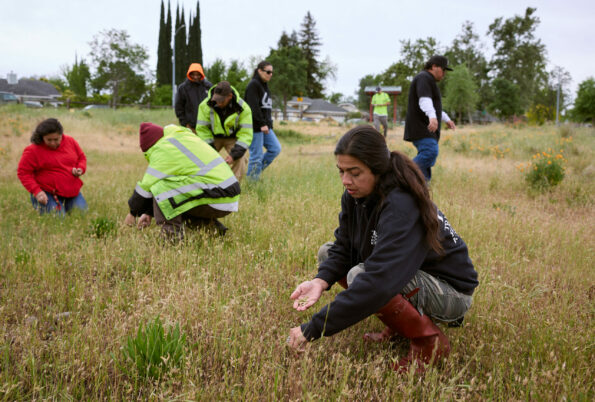
Ali Meders-Knight (foreground) and others return to Verbena Fields to see the effects of their cultural burn. Photo courtesy of Fred Greaves
In addition to the deergrass, many other species of native plants grow at Verbena Fields, including western redbud, buckwheat, cottonwood, California poppy, and yerba mate — historically, for the Mechoopda, a medicine for dehydration and a stimulant for long journeys, Meders-Knight says. And there’s willow, plenty of it. Meders-Knight says visitors are welcome to gather seeds to plant in their own gardens.
In 2020, two decades after Meders-Knight wove her first basket along the Sacramento River, the Mechoopda tribal council passed a resolution naming her the tribe’s master TEK practitioner.
“Instead of having more people against me, I have more people with me,” she says. “It’s a beautiful thing.”
Reporting for this article was made possible by an award from the Institute for Journalism and Natural Resources.
Related Posts
Ensia shares solutions-focused stories free of charge through our online magazine and partner media. That means audiences around the world have ready access to stories that can — and do — help them shape a better future. If you value our work, please show your support today.
Yes, I'll support Ensia!